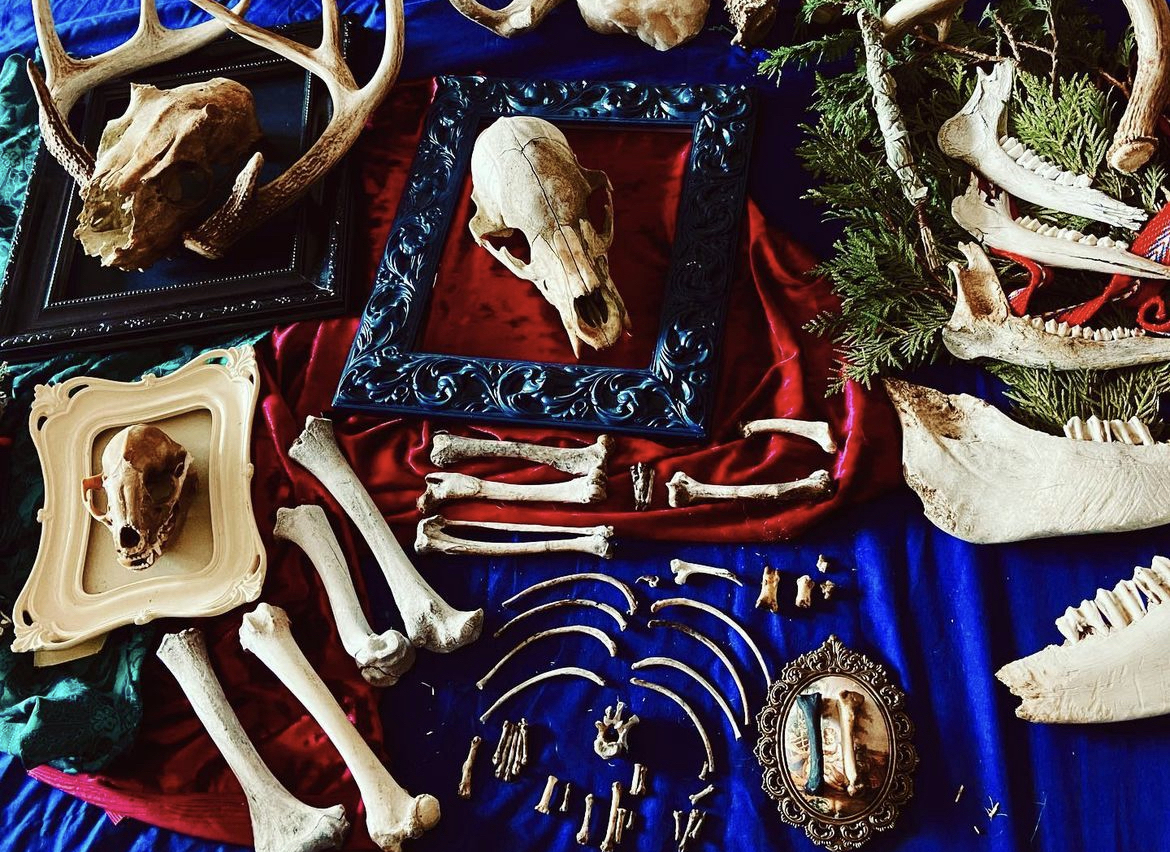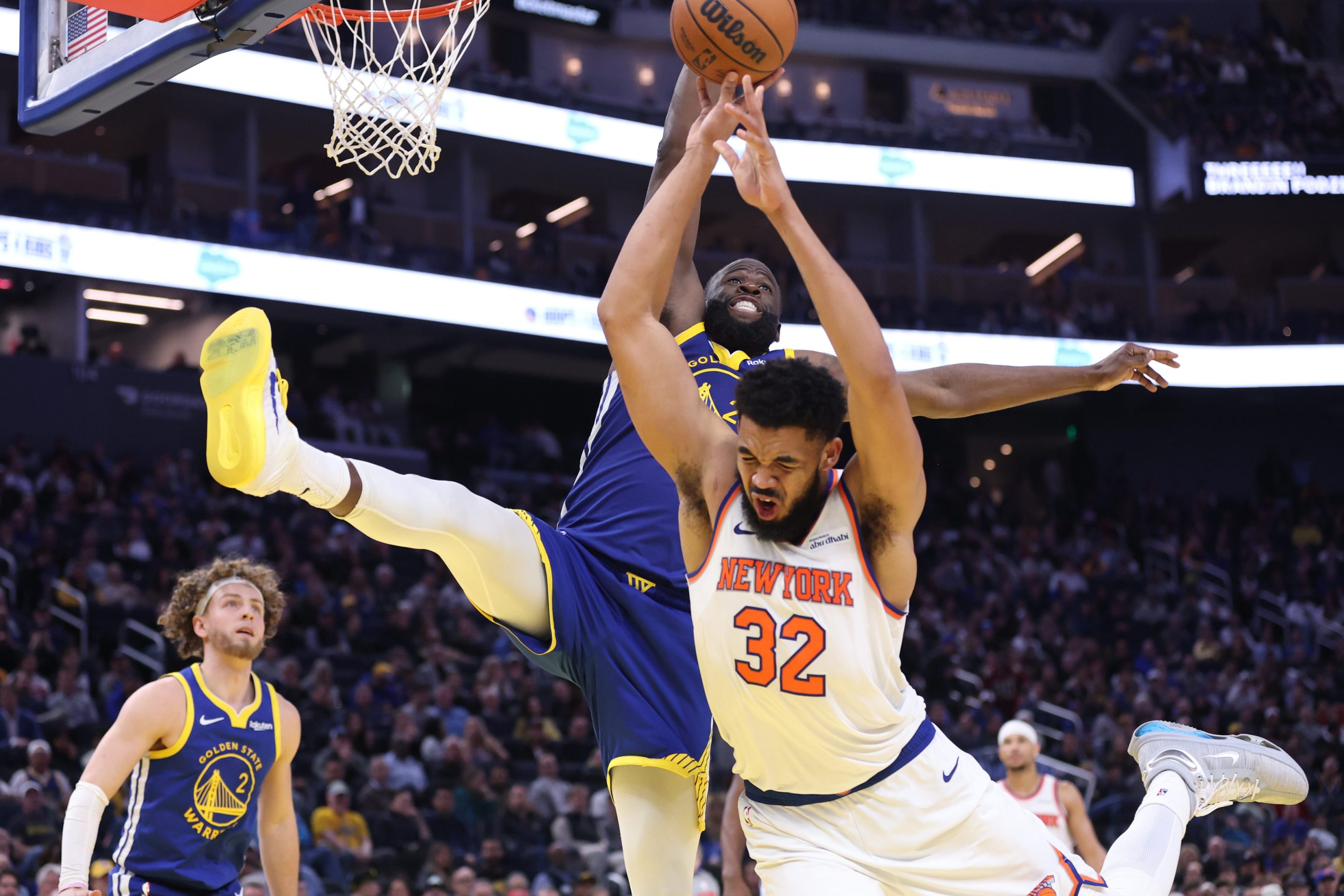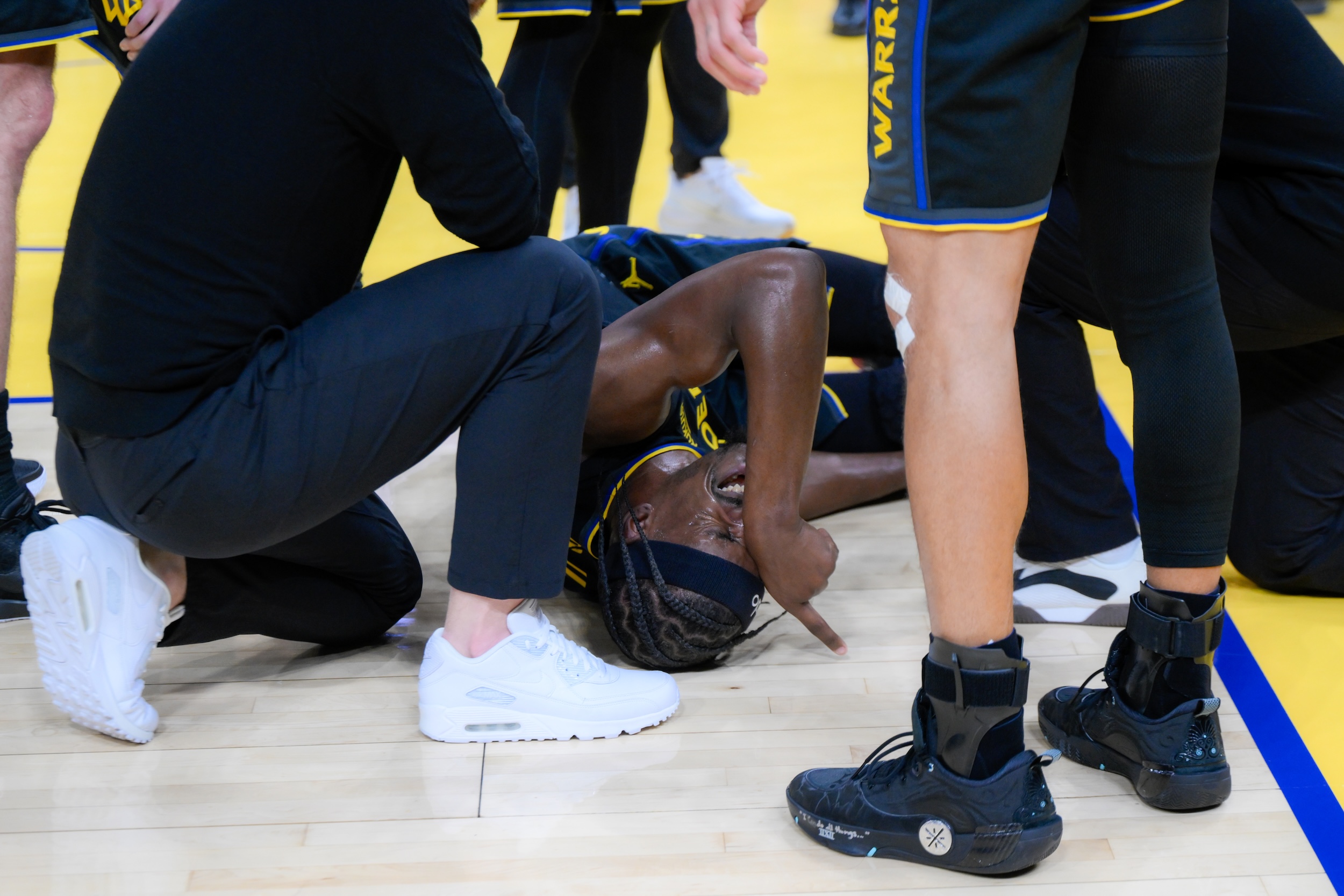There was no better way to find dead animals than to head to the summer witchy market thrown by some local goths. I made my way past the few vendors in the driveway and crossed to the backyard where most of the booths were. The taxidermy booth, Pushing Up Daisies, was busier than the one handing out free beer.
Inside the booth were rows of little skulls and teeth stuck in necklaces and rings, a wall of mounted mid-sized skulls, and a table of large-game showstoppers. I spied raccoon bacula (penis bones) in simple shadow boxes, a lavishly painted cow skull in shiny black with gold trim, and almost endless teeth set in resin alongside ferns and flowers. It gave me pleasant flashbacks to my time working in natural history museums—a deluge of dead things, and I didn’t even have to get my hands dirty.
Sophie Holmes, the owner and taxidermist, turned her attention to me. She was dressed closer to a folk fest attendee than a bona fide witch vendor. By that I mean, she was actually dressed for the summer weather, and she began fanning me with her large pansexual pride flag. I’m not sure if she could see how sweaty I was from my bike ride or if this was a kindness she was imparting on every customer, but I was grateful for the breeze from her pan fan as I looked over her remains.
I came to learn that acts of kindness like these are not uncommon in the Vulture Culture community. In fact, most Vultures say they create out of a sense of empathy and respect for the dead animals they use in their art. “It is ethical and sustainable,” Holmes said. “I’m not here to kill an animal and make a buck off of it.”
Holmes’s interest in Vulture Culture came from her “free-range” childhood, as she put it. She’d find dead things out in the country, and leftover bones from animals her dad had hunted. When I talked to other Vulture Culture artists I heard similar stories, each balancing an innate morbid fascination with a cultivated sense of appreciation for the lives the animals had led.
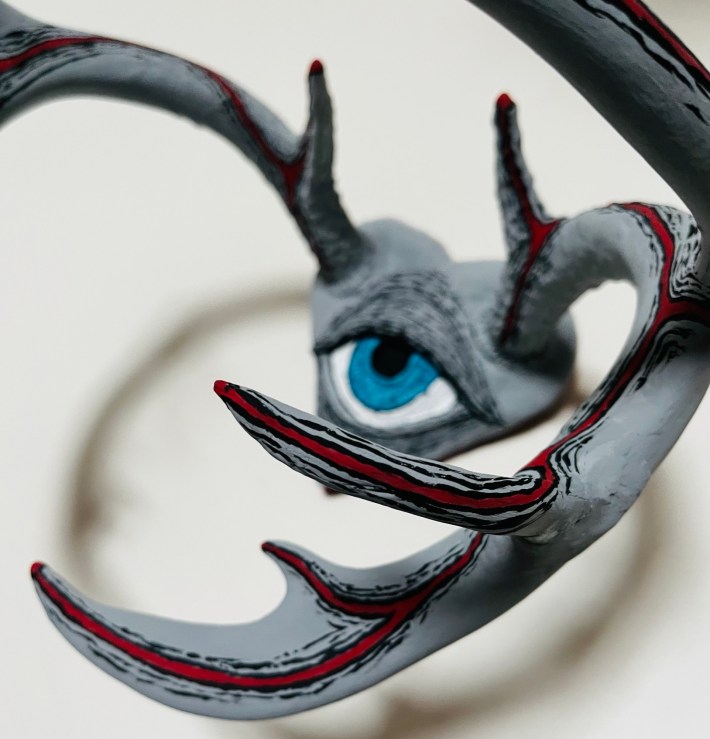
Erzebet Bathory, an Inuk and Ukrainian artist based in Winnipeg, recalled a dried rabbit’s foot that her dad had given her as a kid. “There was this one little piece of tendon sticking out of it and I realized I could pull it and it would flex the foot,” she said. “I took it to school and showed some kids and they were so grossed out.”
Bathory attended an elementary school that followed Ojibwe and Anishinaabe teachings. “Growing up I was always taught to respect nature and to never waste,” she told me, “I know [my interest] had a lot to do with the Indigenous culture of using the animal parts that weren’t edible necessarily, for decorations and regalia.”
My own interest had been piqued online a couple of years earlier, when I came across a photo of many, many dead wasps, posed delicately in paper tissue. Not unusual for me; most of the people I follow are scientists and wildlife enthusiasts. What made this post stand out, though, was the caption: “I will be listing 18 of these wasps to my Etsy as one whole group lot! 🌻.”
Usually when insects are for sale online they’ve been dressed up a little, either set in resin or elegantly mounted, not just laid out wholesale. I’d also never seen someone selling an insect as common and universally loathed as wasps. I learned the wasps had been found dead in the seller’s garage, which was so transparent and mundane that I couldn’t help but be impressed.
This started my fascination with “Vulture Culture,” an aesthetic based on using animal remains— mummified, taxidermied, or skeletonized—in art and jewelry. People have always used animal parts to decorate themselves and their surroundings. But the keyword here is “Vulture”: a reference to the practice of finding or scavenging for these remains, or using ethically sourced materials from animals that otherwise would have gone to waste. Vultures don’t kill; they make use of what’s already dead.
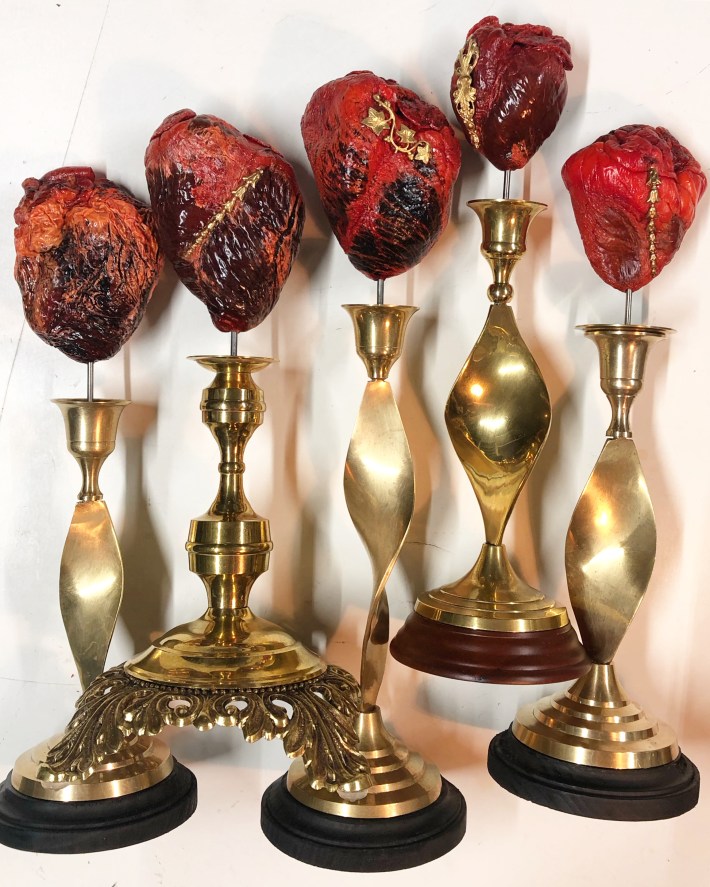
The label “Vulture Culture” started out in online spaces like LiveJournal in the early 2000s, and since the start has been a community that’s more inclusive of women and queer people than commercial taxidermy, which retains some of its history of well-bred men sipping cognac in smoking rooms under a deer head. Vulture Culture aims to subvert the traditions of trophy hunting and unsustainable or unethical collection, by transforming the already-dead into something beautiful—and where no one gets hurt.
Other shops at the witchy market had similar displays to Holmes’s, including a striking pair of male and female praying mantises. The mantises, like my wasps, had lived out their lives and been found dead before being noticed by an aspiring Vulture and collected. But not every animal that ends up as art is so lucky.
The skulls and taxidermy you’ll see in Vulture Culture are rooted in the tradition of cabinets of curiosities, the precursors to natural history museums in Europe, which started out in the homes of the wealthy and worldly in the 1500s. The most prestigious personal collections included items from faraway places, quite often from colonized areas. Culturally significant objects were stolen or purchased from Indigenous people and reduced to their aesthetic value; natural history specimens were removed without regard for ecosystem dynamics; human remains were stolen and displayed without anyone’s permission.
By the 1800s, natural history had become not only affordable but extremely popular, and the practice of preparing one’s own specimens was so ubiquitous that you could find within domestic guidebooks instructions for collecting insects and preserving birds’ eggs, alongside tips for more mundane chores like doing laundry. The demand for specimens fueled an interest in science, but also occasionally environmental devastation. “Pteridomania” or “fern madness” is the nickname given to a Victorian-era fern-collecting fad in England that led to the near-extinction of several endemic species which still have not recovered.
Today, wild-caught animal parts saturate the market, particularly in online spaces like Ebay, Etsy, and Facebook. Vacuum-sealed mummified specimens are readily available as-is, but you can also buy artfully arranged taxidermy displays and jewelry for affordable prices on all these platforms. There’s very little guarantee that what’s on sale was collected any more ethically than it would have been 200 hundred years ago. Bats, insects, and spiders are being caught and killed to fuel the “oddities” trade. Despite policies against the listing of certain animal species, websites have a hard time monitoring all the illegal sales on their sites.
Jana Miller moderates multiple Facebook groups for practitioners and fans of dead animal art. “I don't want my members to get into trouble or my groups to be shut down due to a disregard for the laws,” she said. The onus is on the seller to make sure they’re following the right laws and policies, but if someone is lying or even just misinformed, there’s nothing to stop them and nothing to alert buyers. “I see so many people all over social media saying they are ethically sourced and buyers just take their word for it.”
“It’s tough to be an ethical consumer in Vulture Culture because you have all those pitfalls,” said Lupa, the author of Vulture Culture 101. Lupa, who goes by one name, has been involved with the practice for decades and has seen firsthand that well-meaning laws often have little power. “Yes, technically it’s legal to import Asian bat parts, but they’re basically being poached and it’s not at all sustainable.”
There’s more than one way to skin a cat, and even more ways than that to source one ethically. But what does “ethically” mean when we’re talking about dead animals? “‘Ethically sourced’ is always such a topic that starts drama,” said Miller. “What one person might find to be ethical another may not.”
Bathory only uses bones she’s found herself, or that were found and gifted to her by friends or family. “It’s not so much ‘look what I found!’ It’s more like, ‘this was an animal, now we’re just honoring it.’” She said her ethics have been shaped by her Indigenous upbringing. “Whenever I’ve taken anything from the wild, I carry ceremonial tobacco with me and I give that away, or a coin or stone. Whatever’s special to me, I give as a gift.”
Some Vultures use animal parts that otherwise would have been discarded, like bones left behind by hunters and trappers, or scraps from the fashion industry. “I grew up on a small trapline,” said Holmes, referring to a wooded route where a fur trapper sets their traps, “and I’ve visited a few up north that were very thoughtfully set up.”
Holmes is vegetarian but supports sustainable hunting practices. That doesn’t feel particularly odd to me. In fact, it reminded me a little of my own philosophy around eating meat: I don’t eat very much of it, and when I do, I try to make sure it wasn’t factory farmed or harvested unsustainably. My one exception to this rule is when food would be otherwise discarded—that’s more or less the fundamental rule of Vulture Culture.
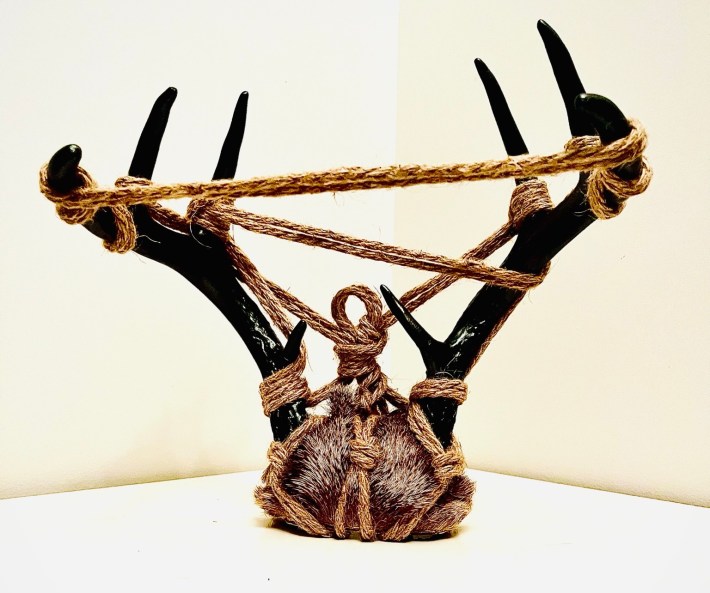
For Lupa, the important thing is that people are transparent in their ethics, and establish boundaries before using or purchasing animal parts. “I’m totally fine with everybody’s ethics being across the board. The only thing I have a problem with is people not talking about it, or not thinking about it,” she said, stressing the need for people to learn about their local collection laws and the ecological impacts of hunting certain species.
When buying ready-made Vulture Culture artwork, you’ll want to set your own ethical boundaries and then do some basic research to make sure your purchase aligns with them. The legalities are fairly straightforward; wildlife protection laws exist to keep vulnerable species from being poached or over-harvested. “If you're going to be a collector of anything natural history–related, you must know and abide by the related laws,” Miller said.
You’ll want to look for official government websites that say if it’s legal to collect, sell, or possess specific animals in your state or province. A big example is the Migratory Bird Treaty Act and its Canadian equivalent, the Migratory Birds Convention Act, which prohibit the trade of migratory bird parts or nests. You’ll also want to find out if you’re looking at a threatened species, which are all listed on the IUCN Red List. It may not seem like a big deal to buy the parts of a threatened species that died of natural causes, but an increased market could drive people to hunt that species unsustainably.
As home natural history displays have increased in popularity thanks to the ease of purchasing specimens online, Miller and other vendors have been disheartened to see illicit sellers profit while Vultures are left behind. “The trend has forgotten about us,” Miller said. She noted that anything you see being sold in large quantities is a red flag that the animals may be being killed and sold commercially. “If it’s coming from outside [your home] country originally, you can almost bet they are poached and illegally imported.”
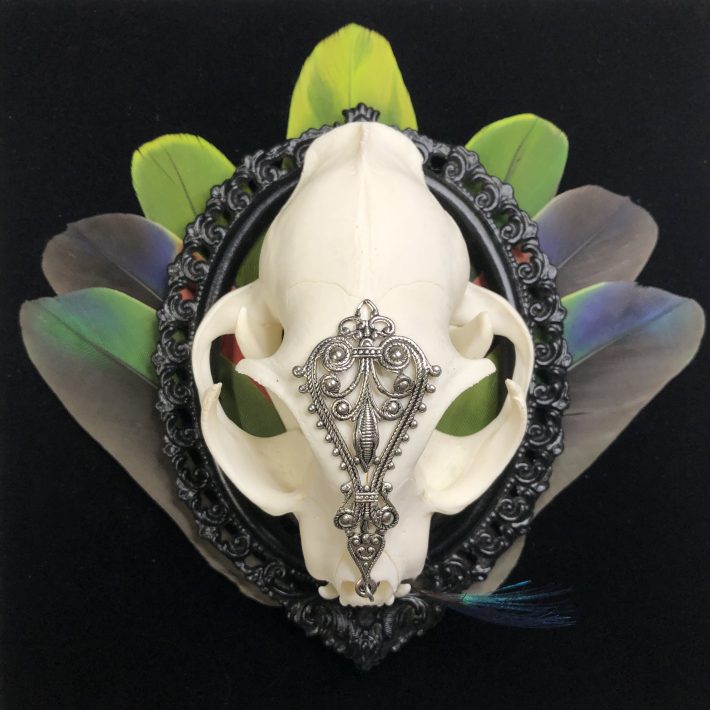
Finally, the trickiest part of buying your Vulture Culture is figuring out if your seller is being honest about where and how they sourced their dead stuff. Ask questions! Most Vultures are eager to talk about their pieces. “If you want the story of the animal I can probably give it to you,” said Holmes, “I ask pretty much anyone who buys a skull if they’d like to know the story of it.”
If you’re still not sure if your seller is on the level, you can ask around in the Vulture Culture community online. Places like Reddit and Facebook are full of experienced Vultures who will be happy to help you figure out your purchase and will recommend trusted sellers.
The more I learned about Vulture Culture, the more I came to think that those wasps I saw might be the ultimate ethically sourced carcasses. They’re not endangered, they’re legal to sell, they’re often hated while they’re alive, and they are exquisitely beautiful, even in death. It’d almost be a shame to let them go to waste.
